It's all about the classical music composers and their works from the last 400 years and much more about music. Hier erfahren Sie alles über die klassischen Komponisten und ihre Meisterwerke der letzten vierhundert Jahre und vieles mehr über Klassische Musik.
Popular Posts
-
Friedrich Smetana was born on March 2, 1824 in Leitomischl, Austria and passed away on May 12, 1884 in Prague/CSSR. Smetana was the son...
-
What's the saddest piece of classical music? We've got some suggestions for the biggest classical tear-jerkers of all time...
-
Walking down the aisle, signing the register, the first dance – let Classic FM London help you plan the classical music for every stage of...
-
– it’s a direct link from heart to heart’ Conductor Vasily Petrenko: “To understand classical music you need no language – it’s a d...
-
Bela Bartok was born on March 25, 1881 in Southern Hungary and passed away on September 26, 1945 as migrant in New York. His father had bee...
Total Pageviews
Sunday, June 18, 2023
Montserrat Caballé - O mio babbino caro
Aretha Franklin, Celine Dion, ... - (You Make Me Feel Like) A Natural Wo...
Love of My Life (Mary Austin)
Love of my life (Queen live @ Houston 1977)
Saturday, June 17, 2023
How Inspiration Strikes
By Georg Predota, Interlude
Ludwig van Beethoven
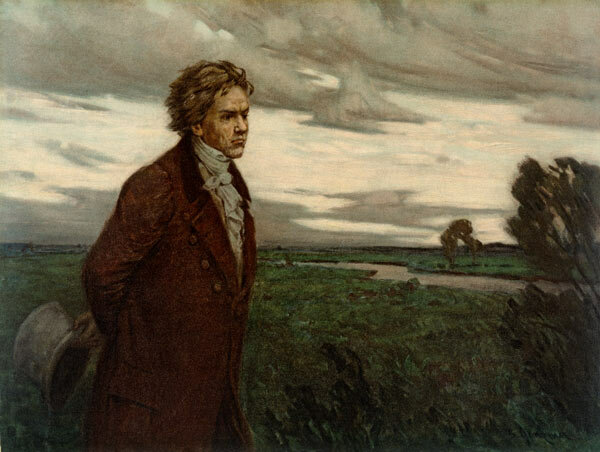
Beethoven on a Walk by Berthold Genzmer
As the American painter, artist and photographer Chuck Close famously stated, “Amateurs sit and wait for inspiration, the rest of us just show up and go to work.” Beethoven, for example, went for vigorous walks through the forests and hills surrounding Vienna after lunch. He always carried with him a pencil and a small pocket sketchbook, recording any musical ideas that would thus come to his mind.
Gustav Mahler

Mahler’s Komponierhäuschen
Gustav Mahler not only locked himself in various Komponierhäuschen (Composer’s cottages), he also took 3 to 4-hour walks after lunch, recording his musical impressions in a notebook.
Benjamin Britten
For Benjamin Britten, afternoon walks were “where I plan out what I’m going to write in the next period at my desk”.
Richard Strauss
Richard Strauss preferred to compose in his garden cottage until lunchtime, when it was time to head for the local restaurant.
Christoph Willibald Gluck
Solitary walking, however, was clearly not the only source of inspiration for great musical minds. Gluck, it was said, wrote best when he was sitting in the middle of a field.
Gioachino Rossini
Rossini was most productive when he had partaken of “a good flask of wine.”
Wolfgang Amadeus Mozart
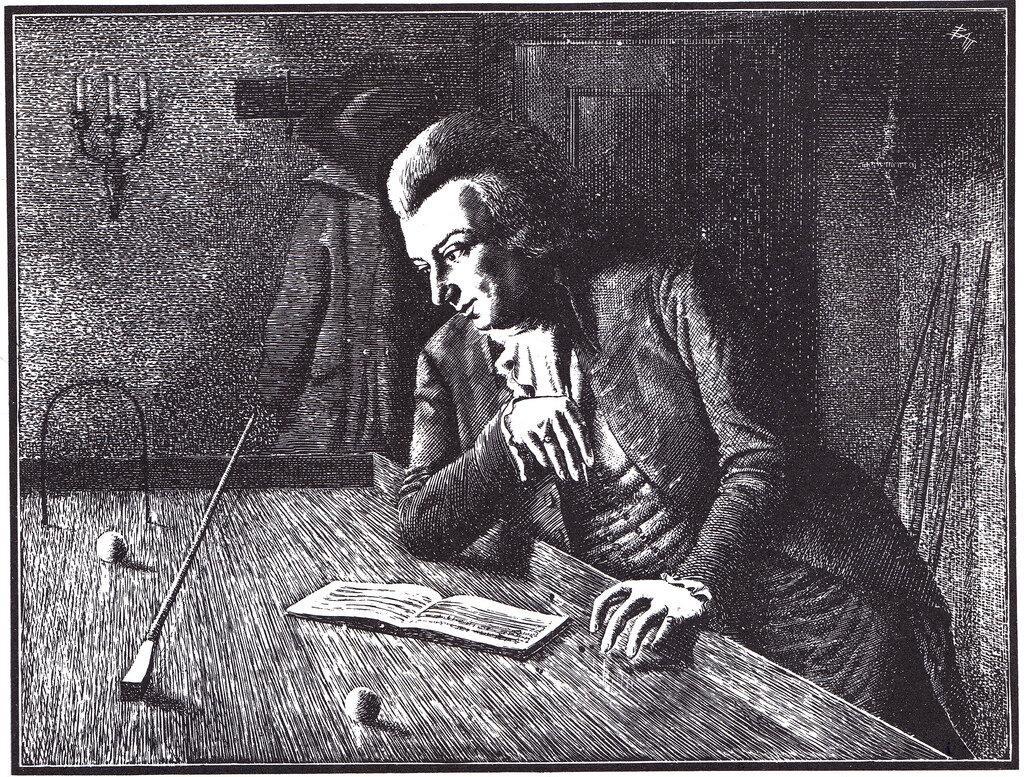
Mozart at the Pooltable by Oswald Charles Barret
It is said that Mozart composed his best music while playing billiards
Giovanni Paisiello
Paisiello enjoyed composing while lying in bed.
Antonio Sacchini
A pretty woman by his side, and his pet cats playing around his feet was a prerequisite for Sacchini to write well.
Giuseppe Sarti
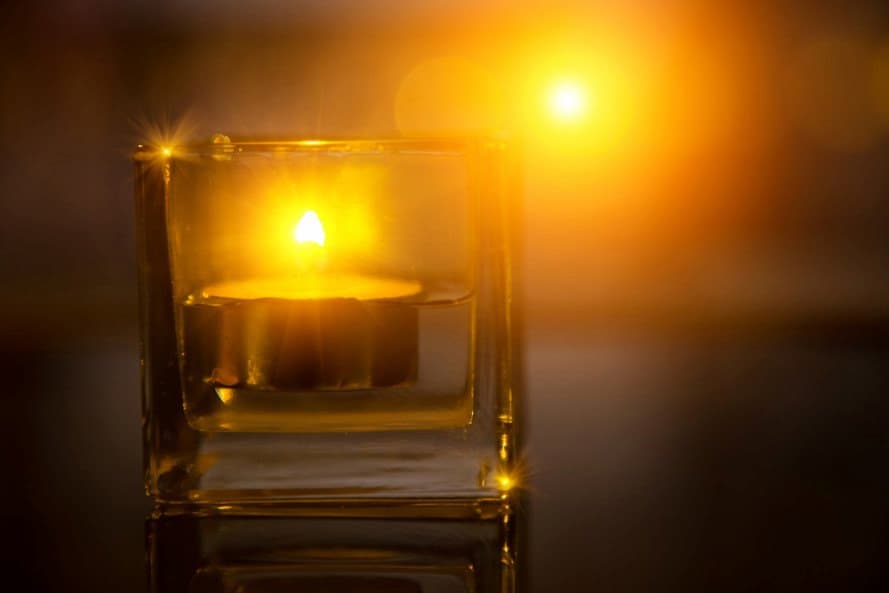
© inhabitat.com
Sarti preferred to sit in a dark gloom lighted only by a single candle.
Domenico Cimarosa
Cimarosa composed his best works surrounded by a dozen of gabbling friends, with light conversation inspiring his music.
Étienne Méhul
Mćhul, on the other hand, trying to get away from the noise and bustle of the city. Once, he went to the Chief of Police in Paris and asked to be imprisoned in the Bastille.
Richard Wagner
And let’s not forget Richard Wagner, who liked his silken undies and heavy perfume in order to be properly inspired. He also needed perfect quiet, and nobody was allowed entrance to his study—it is reported that even his meals were passed to him through a trap door. Believe it or not!
Gershwin’s Forgotten Rhapsody
Gershwin’s Forgotten Rhapsody
We all know George Gershwin (1898–1937) and his Rhapsody in Blue, his 1924 composition that, beginning with an extended clarinet glissando, firmly issued jazz into the world of classical music. The work was commissioned by bandleader Paul Whiteman and received its premiere at Aeolian Hall in New York with George Gershwin at the piano. Gershwin wrote it, Whiteman’s arranger Ferde Grofé orchestrated it, and history was made.
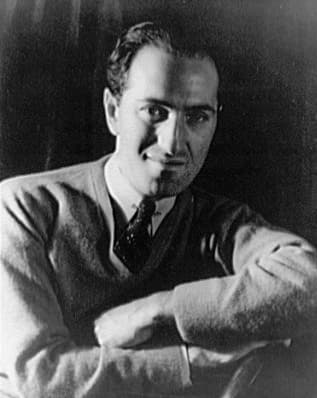
Carl Van Vechten: George Gershwin, 1937
It was written in the 5 weeks between the announcement of the commission (small detail: Gershwin had already declined to do it!) and the concert on February 12, 1924. Gershwin fleshed most of it out on a train trip between New York on Boston, where the ‘rattle-ty bang’ of the train inspired him and by the end of the journey, he had the structure in place. He started formal composition on 7 January and passed the score to Grofé on 4 February, a mere 8 days before the concert.
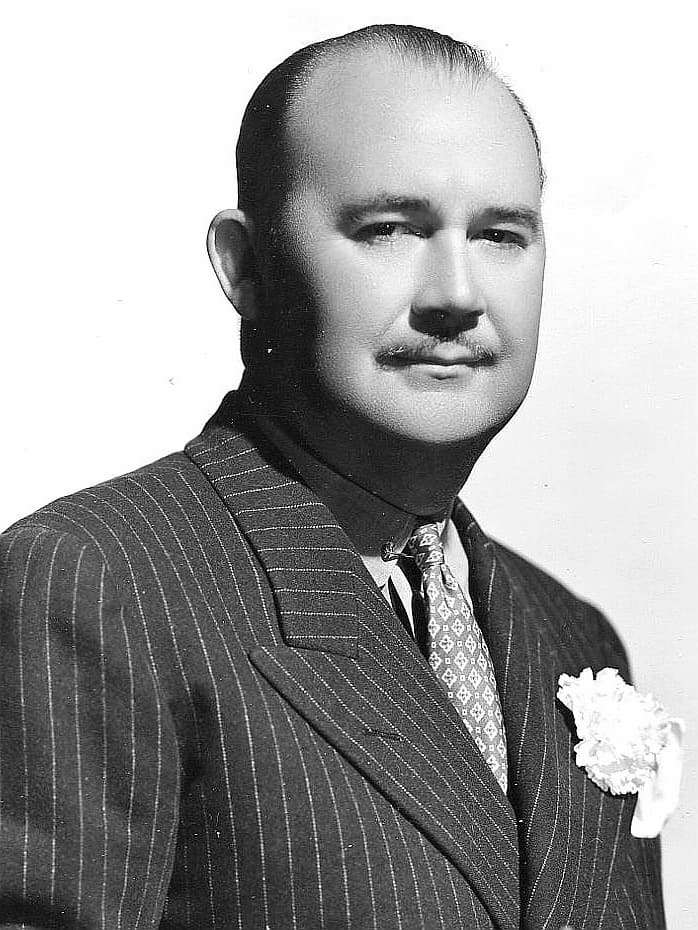
Paul Whiteman
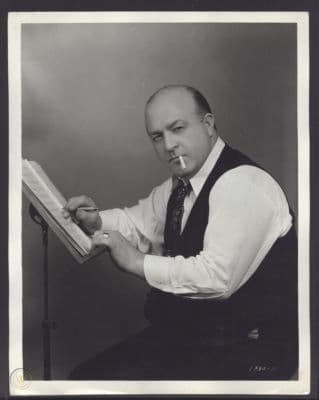
Ferde Grofé, 1935
Billed as “’An Experiment in Modern Music”, Whiteman’s classical/jazz concert had 26 different pieces on the programme. Gershwin’s piece was no. 25. The earlier works hadn’t always been successfully received and the ventilation system in the hall wasn’t working. Gershwin took his place at the piano and with that unmistakable wail on the clarinet, the fleeing audience was stopped in its tracks and a new era in classical music was born.
What’s been largely overlooked, however, is that Gershwin wrote another jazz concerto, the Second Rhapsody. In 1931, Gershwin was in Hollywood, writing music for the movies, when he was asked for a six-minute instrumental interlude for the movie Delicious, an early colour film set in Manhattan involving a newly arrived Scottish girl who falls in with a miscellaneous group of immigrant musicians.

“Delicious” film poster
Gershwin wrote more music than Fox Studios needed and nearly half of his music ended up on the editing room floor, but Gershwin took it to the recording studio on its own. It was given its concert premiere in January 1932 by the Boston Symphony Orchestra under Serge Koussevitzky, with Gershwin as soloist.
The most common version heard for the first 50 years after its composition was a re-orchestration done by Robert McBride, as commissioned by the music editor at Gershwin’s publisher. In this edition, Gershwin’s original vision has been simplified, voices reassigned (for example, the string quartet portion of the adagio was rescored for violin, clarinet, oboe, and cello), and former solo lines were now doubled. Also, 8 measures cut by Gershwin were added back in by McBride. The soloist is Gershwin’s friend, Oscar Levant (1906–1972).
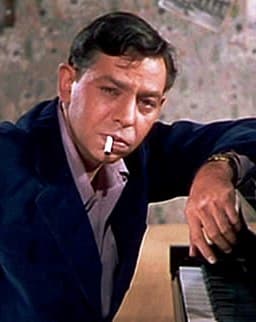
Oscar Levant in An American in Paris, 1951
Various versions ended up in circulation – some cut down by Gershwin, some cut down by other editors – and it’s only since 1985, when conductor Michael Tilson Thomas started researching the original version that Gershwin wrote, that we start to approach the original. MTT recorded what he found with the San Francisco Symphony Orchestra in 1985.
The motifs are pure New York in the 1930s: the hammering motif at the beginning depicts riveters at work on the city’s skyscrapers, remember that the world’s tallest building, the Empire State Building, was begun in 1930 and completed in 1931, dominating the New York skyline until the World Trade Center towers eclipsed it in 1970.

Empire State Building, 2012
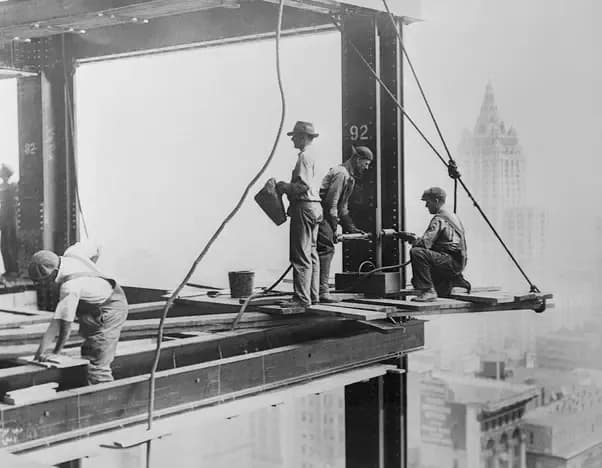
Riveters at work
This is what gave the work one of its earliest names: Rhapsody in Rivets. It was next given the title of New York Rhapsody, then Manhattan Rhapsody before Second Rhapsody came to the fore. In addition to the rivets, other elements of the city come in as well, with Latin rhythms providing a driving force along with the rivets. Jazz and blues also have their place. This performance by Freddy Kempf says it’s ‘in the original 1931 orchestration by the composer’.
Some blame the excessive percussive rhythms for the work’s lack of popularity, others for the lack of a definitive score that preserves Gershwin’s original ideas. The Gershwin family, as part of a larger project to create scholarly editions of Gershwin’s music in conjunction with the Library of Congress and the University of Michigan, is working on a definitive edition of the work that should help it get back onto the concert stage.
Thursday, June 15, 2023
Cole Porter "High Society" Overture - John Wilson Orchestra
Les Femmes “Compositeurs” : Piano Music by French Romantic Women Composers
by Hermione Lai
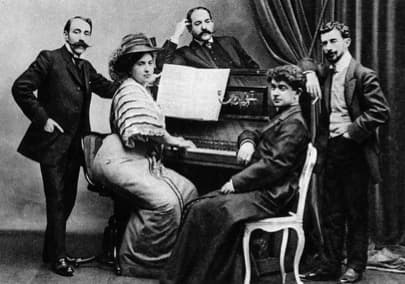
Music salons of Belle Époque Paris
The piano was the most important musical instrument in the home “because it was useful as both a solo instrument and as accompaniment to a group of singers or instrumentalists.” In essence, the piano was the axis of cultural, communal, and family life. The grand piano became a powerful symbol of the aristocratic salon, but to accommodate home use, smaller pianos were created. Square pianos and uprights took up less space and they were less expensive. “With the technological advances of the Industrial Revolution, the mass manufacturing of musical instruments, especially pianos provided a seemingly endless supply for huge markets.
Les Femmes “Compositeurs” eagerly contributed a delightful piano repertoire of richness and complexity, one that is nevertheless, not exclusively tied to the salon. In this blog let us sample piano music by French Romantic Women Composers, starting with 5 Pieces by Mélanie Bonis.
Mélanie Bonis: Cinq pièces pour piano, Op. 11
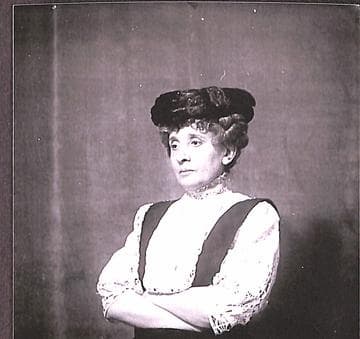
Mélanie Bonis, 1907
Mélanie Bonis (1858-1937) and Claude Debussy were fellow students at the Paris Conservatoire. Interestingly, Bonis was rather critical of his impressionistic compositions. As she writes, “In music, harmony corresponds to colour in painting, to building materials in architecture. Debussy uses the most precious materials, brilliant and opaque jewels, but his constructions have neither plan nor scale. He is a delightful illustrator of short little things.” Bonis, on the other hand, felt strongly drawn to traditional forms, but unlike Debussy, she was denied veritable success during her lifetime. She had been forced to discontinue her studies, and prevented from marrying the man she loved. Her parents pushed Bonis into a marriage with Albert Domange, 22 years her senior who brought five children into the marriage. They stayed together for 35 years, but Bonis never gave up composing and left us a substantial collection of piano music. The “Cinq pièces pour piano” are charmingly light and elegant, and you can easily hear the influence of Schubert in the opening impromptu, Mendelssohn in the song without words, and Schumann in the concluding “Papillons.”
Virginie Morel du Verger: 8 Études mélodiques
Virginie Morel (1799-1869) is not a household name, and I must confess that I had never heard of her before the Palazetto Bru Zane published its anthology of French Romantic Women Composers. There is very little biographical information available, but she was apparently born in Metz and taught herself to play the piano. By the age of 12 she “played the piano remarkably well,” and after she entered the Paris Conservatoire in July 1813, she quickly gained attention. The composer Méhul noted, “She has the greatest potential to become a leading pianist.” True to his words, Morel won the Premier Prix in piano the following year and completed her education by taking private lessons with Reicha (in harmony), Clementi, and Hummel. Her first compositions are dedicated to the Duchesse du Berry, and her arranged marriage to the chief of staff in the Armée d’Afrique took her away from musical life in Paris. In fact, she spent ten years in Algiers before returning to France.
Upon her return, Morel continued to teach and compose, writing music for her own instrument. And that includes the collection of Huit Études mélodiques published in 1857 and dedicated to Louise Farrenc. The title “Études” is somewhat misleading as these are not pedagogical words. As the liner notes tell us, “Despite being fraught with various difficulties, these eight short pieces are intended for a salon performance, and as a demonstration of the expressive talent of both the performer and the composer.” As Ernest Reyer wrote on 31 July 1857 in the Revue musicale, “The artistic world still remembers Miss Morel’s successes; and as the skillful pianist became a noble lady, she remained faithful to her art and to the only traditions she ever accepted, those of the great masters. Each page of the work gives a feeling of virility and experience: feminine grace is hidden in the titles the composer gave to each of the melodies that form her collection: ‘La berceuse’ (‘Lullaby’), ‘L’incertezza’ (‘Uncertainty’), ‘Barcarolle’, ‘Le papillon’ (‘The butterfly’), etc. These fresh poetical thoughts are preceded by a very beautiful introduction in which both parts, equally interesting and eventful, reveal the masterly touch of a hand that never fumbles.”
Marie Jaëll: Voix du printemps
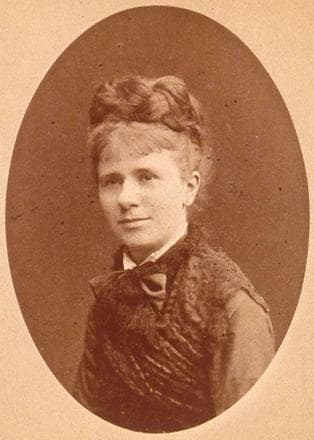
Marie Jaëll
With the piano taking center stage in the salons and living rooms of the 19th century, music became a widely accepted form of home entertainment. As my colleague once wrote, “and when two people sit at one instrument sharing space and often the same notes, the interactive side of music making is elevated to a physical level.” Performance by two players simultaneously sharing a single piano requires not only a level of intimacy unique to chamber music, it also presents its own set of technical challenges. There are some notable exceptions, but the piano four hands repertoire is primarily associated with domestic music making. Marie Jaëll (1846-1925) composed a collection of music for four hands in 1885 and titled it Voix du printemps. She premiered the work with pianist Lucie Wassermann in February 1886 at the Salle Érard. A critic considered these works “full of verve, and of the best style.” Les Voix du Printemps “sing in a pleasant rural setting, and if the storm disturbs the tranquility, it is to bring a necessary dramatic contrast.”
Mélanie Bonis: 6 Pièces à quatre mains, Op. 130
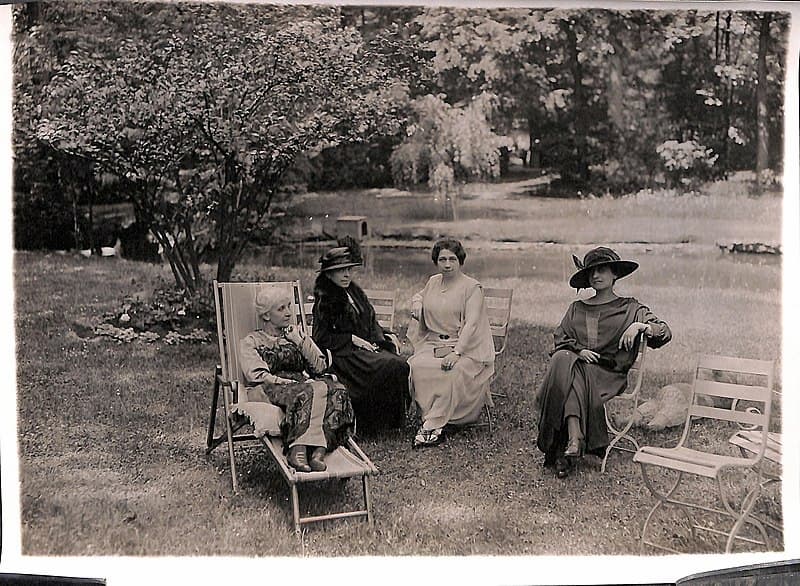
Composer Mel Bonis (on the Left in the lounge chair) enjoying a picnic with friends
Cécile Chaminade: 6 Pièces romantiques, Op. 55
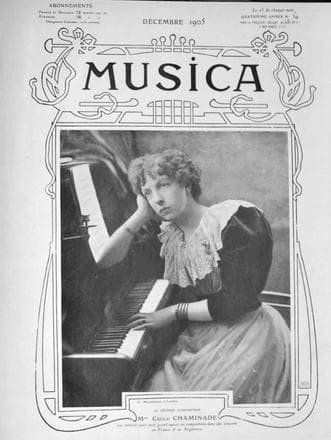
Cécile Chaminade
Cécile Chaminade (1857-1944) was born into an upper-middle-class family and her father was against his daughter having a professional musical education. The family did hold regular salons at their house and Cécile made the acquaintance of various musicians who helped her to arrange for her first public performance at the Salle Pleyel in 1877. A critic writes, “the death of her father and the need to provide for her family prompted her, from the 1890s, to give frequent international concert tours and sign publishing contracts which obliged her to produce at speed a large number of minor works which generally lack the harmonic sophistication of her early compositions.” Personally, I don’t hear that lack of harmonic sophistication in her Six Pièces romantiques op. 55 composed around 1890. The poetic qualities of this set are described in the titles of individual pieces and orient themselves by two very popular subjects of the time, nature and exoticism. Just listen to the pastoral freshness and elegant lines and harmonies in “Primavera,” and the modal touches and arpeggiated chords of some plucked string instruments as it evokes a distant land in “Idylle arabe.”
Charlotte Sohy: Piano Sonata, Op. 6
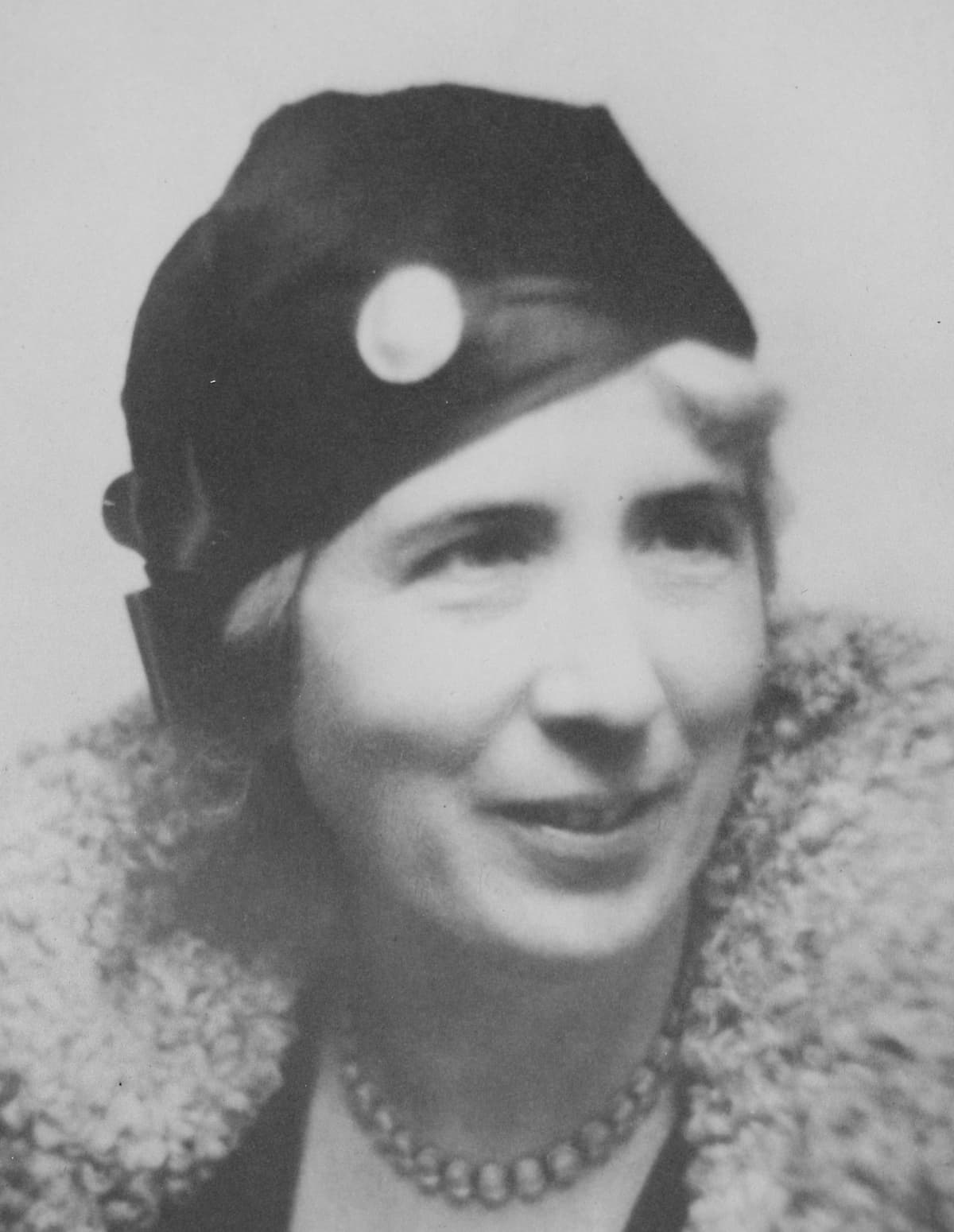
Portrait of Charlotte Sohy
Piano compositions by Les Femmes “Compositeurs” were clearly not exclusively bound to gentle afternoon performances at the salon. In the case of Charlotte Sohy (1887-1955), her Piano Sonata Opus 6 first sounded at a concert given by the Société Nationale de musique on 9 April 1910. Sohy had been a student of Vincent d’Indy and the Schola Cantorum, and a younger generation of avant-garde composers led by Maurice Ravel eyed her with great suspicion. Nevertheless, a critic present at the performance wrote, “The piano sonata by M[onsieur] Ch. Sohy has the great merit of being short and to the point; the author knows what he wants to say and how to say it and has no intention of saying too much. He is to be encouraged in that approach, and it cannot be denied that the first two movements offer some personal qualities as well as some delightful sounds, and the third one, in the form of a rondo based on a Russian dance theme, moves fervently and with ease through many varied tonalities.” As you can tell, Charlotte concealed her gender by signing the work as “Ch. Sohy,” which the critic automatically assumed was a man.
Hélène-Antoinette-Marie de Nervo de Montgeroult: Piano Sonata in F minor, Op. 5 No. 2
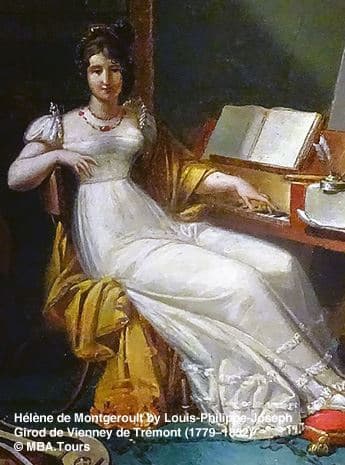
Hélène-Antoinette-Marie de Nervo de Montgeroult
The F-minor piano sonata by Hélène de Montgeroult (1764-1836) was first published in 1811. Born Hélène de Nervo in Lyon, she was “often regarded as the greatest virtuoso of her time, which could have guaranteed her a prestigious career, had her aristocratic background not forced her to remain within the narrow confines of the Paris salons.” She was a student of Dussek and Clementi, and the first woman appointed professor of piano at the Paris Conservatoire in 1795. As such, “she actively helped to train the first virtuosos of the 19th century, including Cramer and Boëly. And it seems that music also saved her life. During the Reign of Terror in Revolutionary France, she was imprisoned and had to appear before the Committee of Public Safety. Faced with being marched to the guillotine, de Montgeroult was asked to prove that she might be useful for patriotic events. A piano was brought in and she was asked to perform “La Marseillaise.” After playing the tune, so the story goes, “she began to improvise a set of variations with the music gradually building to a great climax, the melody billowing out over arpeggios.” Having moved everybody to tears, Hélène de Montgeroult was quickly released.
Her biographer Jérôme Dorival considers de Montgeroult a bridge between classicism and romanticism. He described her as “the missing link between Mozart and Chopin.” The featured piano sonata shows an “unexpectedly early influence on French composers of the Germanic piano repertoire, and in particular the works of Beethoven.” It is a highly dramatic composition in which the musical material is highly unified. “The first theme of the Allegro thus proceeds by successive amplifications and transformations, while the second theme is of a more songful character. The second movement features two highly expressive themes, and the work ends with a spirited fast movement full of tonal contrast, setting this sonata firmly in the vein of early Romanticism.”
Mélanie Bonis: Suite en forme de valses, Opp. 35-38, No. 1
Let us conclude this little survey of piano music by French Romantic Women Composers with the delightful Suite en forme de valses by Mel Bonis. This suite exists in several versions, all composed in 1898. There is a version for orchestra and solo piano and one for piano four hands in five movements. The version of piano four hands is not a transcription of the orchestral version. As the liner notes tell us, “technically accessible to amateur pianists, the Suite en forme de valses was intended for domestic use, but the composer also displays new ambitions in confronting here the orchestra for the first time.” Please join us next time for a concluding survey of delightful French mélodies composed by Les Femmes “Compositeurs.”
The Widows of Bach, Mozart, and Mendelssohn: What Happened to Them?
by Emily E. Hogstad
However, historians tend to stop following the story once the composer dies. But have you ever wondered what happened to the composer’s families after their deaths? How did their widows keep their composer-husband’s music alive? And in eras before social safety nets, how did they survive…especially if they had kids?
Here’s what happened to three of classical music’s most famous widows after their husbands died:
Anna Magdalena Bach, 1701-1760. Married Bach in 1721.
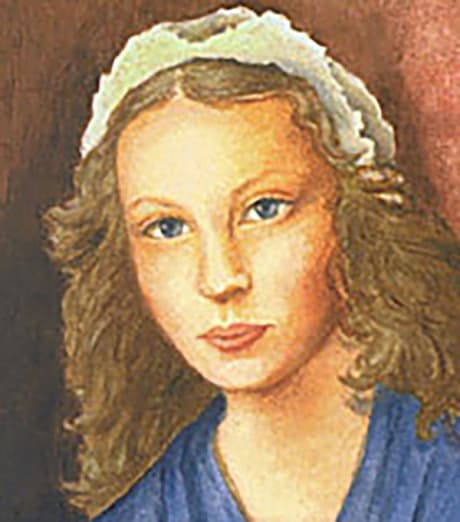
Anna Magdalena Bach © www.bachueberbach.de
Anna Magdalena had just turned twenty when she married the widower J.S. Bach. In doing so, she became a very young stepmother to four surviving children, aged thirteen, eleven, seven, and three, all from his first marriage. Soon she began having biological children of her own. She would have thirteen in all, with seven dying very young.
When her husband died, Anna Magdalena Bach was forty-eight years old. She had been an accomplished professional singer in her youth, but she was in no position to restart her performing career…not to mention, she still had several minor children to raise!
Unfortunately, Bach hadn’t left enough money for them all to live on. She was left a portion of his estate, but J.S. Bach’s children, including his adult sons who were pursuing careers of their own, also got a cut of the assets, too. And alarmingly, the city of Leipzig only granted Anna Magdalena custody of her children on the condition that she not marry again, guaranteeing their future destitution.
Her stepson C.P.E. Bach was apparently the only child who stepped in to provide financial assistance, but it did not keep her from sinking into extreme poverty. She was evicted from her home and needed assistance from the city government to survive. She died a decade after her husband and was buried in an unmarked pauper’s grave.
Constanze Mozart, 1762-1842. Married Mozart in 1782.
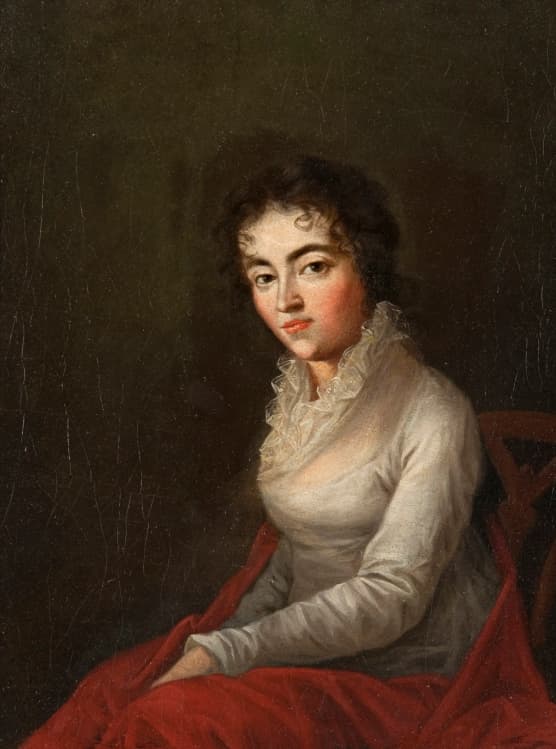
Constanze Mozart
Mozart’s wife Constanze was twenty-nine years old when her husband fell ill and died, leaving her with two children, debts, and few prospects. She roused herself from her grief to line up support for herself, seeking out a pension from the emperor and organizing memorial concerts. She was a singer, and she put her musical abilities to use when she started publishing her dead husband’s works. Eventually, she grew to become a wealthy woman.
Six years after Wolfgang’s death, she took in a tenant named Georg Nikolaus von Nissen, a diplomat, and a writer. Romance blossomed. Rather scandalously, they moved in together the following year. They married in 1809, with von Nissen taking on the role of stepfather and helping Constanze with the administration and promotion of Mozart’s legacy.
Nissen’s last project was a Mozart biography, with which Constanze assisted. Nissen died before it was finished, but she made sure it was published, and it became an important source of Mozart lore. She lived in Salzburg along with two of her sisters, also widowed, and died in 1842 at the age of eighty.
Cécile Mendelssohn Bartholdy, 1817-1853. Married Mendelssohn in 1837.
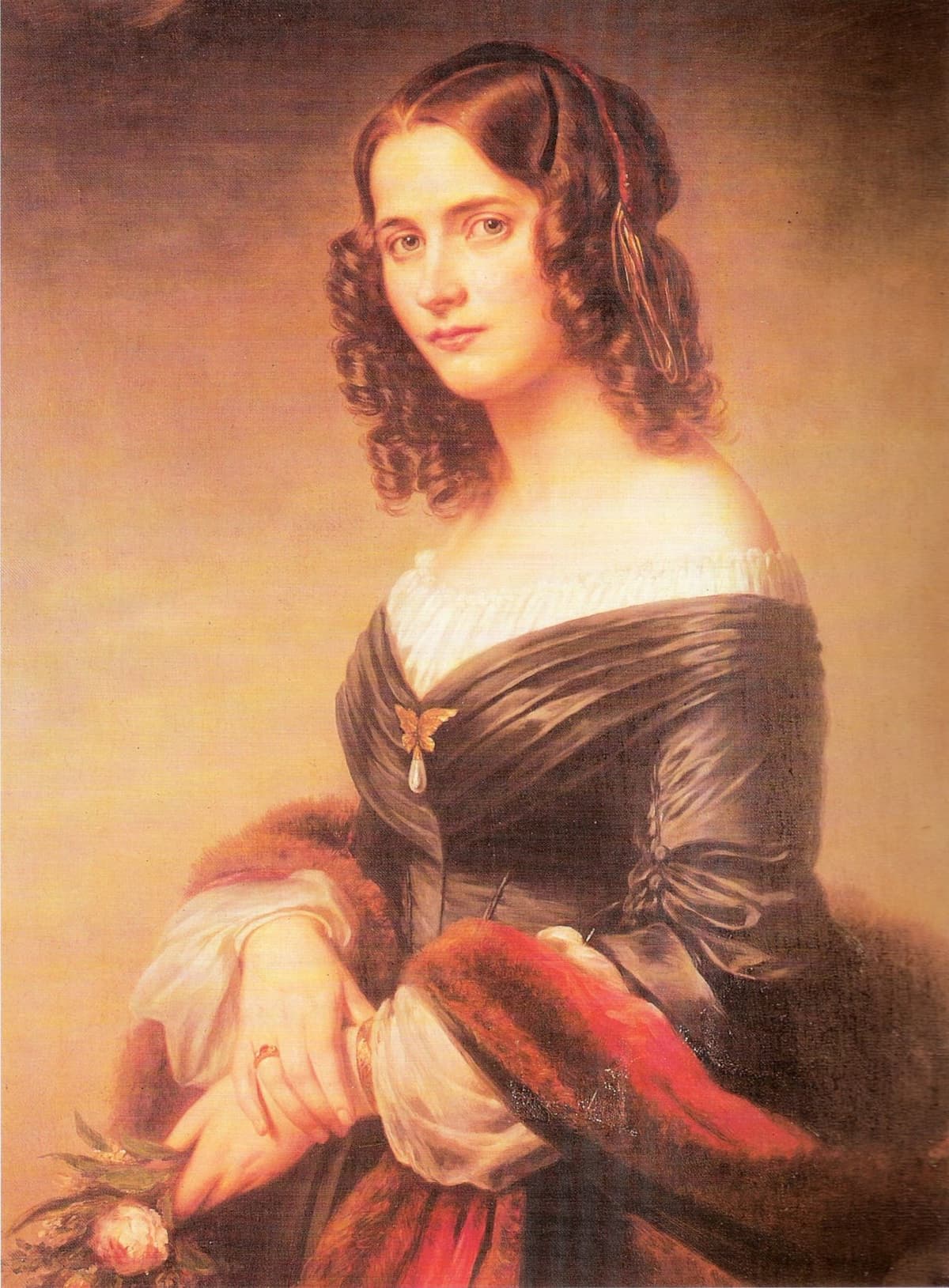
Cécile Mendelssohn Bartholdy
Twenty-seven-year-old composer Felix Mendelssohn met nineteen-year-old singer Cécile Jeanrenaud in 1836 while he was conducting the Cecilia Choir in Frankfurt. They got engaged that September and were married in March 1837, and had five children together in Leipzig.
Unfortunately, tragedy hit the family in May 1847, when Felix’s beloved sister Fanny died suddenly and without warning of a stroke. Felix was deeply affected by her death, and he died in November 1847, also from a stroke. Cécile was only thirty.
Clara Schumann went to be with her and wrote: “She received me with the tenderness of a sister, wept in silence, and was calm and composed as ever. She thanked me for all the love and devotion I had shown to her Felix, grieved for me that I should have to mourn so faithful a friend, and spoke of the love with which Felix always had regarded me. Long we spoke of him; it comforted her, and she was loath for me to depart. She was most unpretentious in her sorrow, gentle, and resigned to live for the care and education of her children. She said God would help her, and surely her boys would have the inheritance of some of their father’s genius. There could not be a more worthy memory of him than the well-balanced, strong, and tender heart of this mourning widow.”
She kept her two daughters with her and sent her three sons to be raised by her in-laws in Berlin. Her son Felix died in 1851, compounding her grief, and she herself died of tuberculosis in 1853, leaving behind several children aged eight to fifteen.

